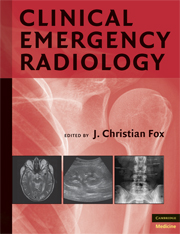Book contents
- Frontmatter
- Contents
- Contributors
- PART I PLAIN RADIOGRAPHY
- PART II ULTRASOUND
- 12 Introduction to Bedside Ultrasound
- 13 Physics of Ultrasound
- 14 Biliary Ultrasound
- 15 Trauma Ultrasound
- 16 Deep Venous Thrombosis
- 17 Cardiac Ultrasound
- 18 Emergency Ultrasonography of the Kidneys and Urinary Tract
- 19 Ultrasonography of the Abdominal Aorta
- 20 Ultrasound-Guided Procedures
- 21 Abdominal—Pelvic Ultrasound
- 22 Ocular Ultrasound
- 23 Testicular Ultrasound
- 24 Abdominal Ultrasound
- 25 Emergency Musculoskeletal Ultrasound
- 26 Soft Tissue Ultrasound
- 27 Ultrasound in Resuscitation
- PART III COMPUTED TOMOGRAPHY
- PART IV MAGNETIC RESONANCE IMAGING
- Index
- Plate Section
27 - Ultrasound in Resuscitation
from PART II - ULTRASOUND
Published online by Cambridge University Press: 07 December 2009
- Frontmatter
- Contents
- Contributors
- PART I PLAIN RADIOGRAPHY
- PART II ULTRASOUND
- 12 Introduction to Bedside Ultrasound
- 13 Physics of Ultrasound
- 14 Biliary Ultrasound
- 15 Trauma Ultrasound
- 16 Deep Venous Thrombosis
- 17 Cardiac Ultrasound
- 18 Emergency Ultrasonography of the Kidneys and Urinary Tract
- 19 Ultrasonography of the Abdominal Aorta
- 20 Ultrasound-Guided Procedures
- 21 Abdominal—Pelvic Ultrasound
- 22 Ocular Ultrasound
- 23 Testicular Ultrasound
- 24 Abdominal Ultrasound
- 25 Emergency Musculoskeletal Ultrasound
- 26 Soft Tissue Ultrasound
- 27 Ultrasound in Resuscitation
- PART III COMPUTED TOMOGRAPHY
- PART IV MAGNETIC RESONANCE IMAGING
- Index
- Plate Section
Summary
INDICATIONS
Many critical conditions are rapidly and accurately detected by bedside clinical sonography. In fact, ultrasound in resuscitation is a necessary tool for evaluating the emergent and unstable patient presenting to the ED. Patients may complain of sudden onset of pain in the head, thorax or abdomen, and pelvis. Patients may present in cardiac arrest or with altered mental status and, therefore, will be unable to provide any history at all. Physical exam findings such as unstable vital signs, absent, irregular or muffled heart sounds, absent lung sounds or rales, abdominal distension or tenderness, and pulsatile abdominal masses all necessitate expedient evaluation of the patient. Point-of-care bedside ultrasound will direct the emergency physician down an algorithmic pathway to focus on the potential organ system(s) involved. Of primary concern to the acute care physician are emergent airway, breathing, and circulation instabilities. Hemodynamic monitoring in a patient presenting with a mixed and complex clinical picture is crucial. Because of the many potential causes of an unstable patient (see Tables 27.1, 27.2, 27.3, and 27.4), an algorithmic use of sonography, especially tailored to the key clinical conditions of dyspnea and circulatory failure, is included in this chapter. Particular symptoms, signs, or other imaging results will direct the physician in how best to apply ultrasound to patient care.
Keywords
- Type
- Chapter
- Information
- Clinical Emergency Radiology , pp. 367 - 396Publisher: Cambridge University PressPrint publication year: 2008

